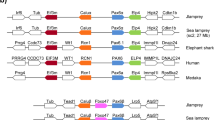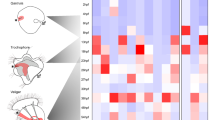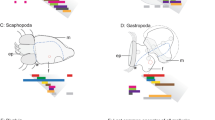Abstract
Arising from: M. J. Cohn Nature 416, 386–387 (2002). In vertebrates with jaws (gnathostomes), the jaws are formed from the first pharyngeal arch (PA1), which does not express homeobox (Hox) genes. Cohn1 describes expression of the HoxL6 gene in the PA1 of the lamprey Lampetra fluviatilis, a jawless (agnathan) vertebrate, and postulates that a retreat of Hox expression from PA1 might have favoured the evolution of jaws in the gnathostome lineage after the split from agnathans1. Here we examine the distribution of Hox genes in another lamprey species, Lethenteron japonicum, and find that none are expressed in the PA1. We conclude that Cohn's finding is not a general feature within the lamprey group and is therefore unlikely to be related to jawlessness.
Similar content being viewed by others
Main
In gnathostome embryos, Hox genes display rostral boundaries of expression that are collinear with their relative chromosomal positions2,3. Nested collinear Hox expression patterns display sharp anterior boundaries that map to distinct hindbrain segments (rhombomeres) and pharyngeal arches that give rise to the neural-crest-derived skeletal structures in the head and neck region4. Notable exceptions are the first rhombomere (r1) and the jaw-forming first pharyngeal arch (PA1), which do not express Hox genes. Analysis of Hox expression patterns in the jawless lamprey may therefore provide insight into how the gnathostome Hox code has been established and its relevance to the evolution of craniofacial structures in vertebrates.
We isolated 11 Hox complementary DNAs from embryos of the Japanese lamprey L. japonicum (Lj). Alignment of the deduced amino-acid sequences of isolated cDNAs, as well as phylogenetic comparisons, revealed that they belong to paralogue groups (PG) 2 to 9, designated LjHox2, -3d, -4x, -4w, -5i, -5w, -6w, -6/7m, -8p, -Q8 and -9r, respectively (GenBank accession numbers: AY497314, AB125269–AB125278; Fig. 1a). On the basis of comparison of the nucleotide sequences, LjHox4x, LjHox4w, LjHox5w, LjHox6w and LjHoxQ8 are the orthologues of Hox4x, Hox4w, Hox5w, Hox6w and HoxQ8, respectively, in Petromyzon marinus5,6,7, a lamprey species belonging to a different genus. P. marinus has three or four Hox clusters5,6,7. Our results from L. japonicum are in keeping with this, as we never isolated more than three Hox genes from any single cognate group.
a, Alignment of deduced amino-acid sequences of LjHox genes with those of other chordates and the assignment of paralogue groups (PGs) are shown. Homeodomains are indicated in green and the YPWM motif, which is unique to Hox PG1-8 genes, in pink. LjHox sequences are shown in bold. Amino acids characteristic of each paralogue group are in yellow. b, Alignment of LjHox6w and Lampetra fluviatilis (Lf) HoxL6 nucleotide sequences with their deduced amino-acid sequences. Intronic regions are shaded; homeodomains are in green. Substituted nucleotide sites between the two sequences are in bold. Note that the intronic regions have accumulated a few changes and that the only two substitutions in the exonic region are synonymous.
All the LjHox genes are strongly expressed at the pharyngula stage. In the neural tube, LjHox PG2–8 genes display offset rostral expression borders, moving from anterior to posterior (Fig. 2a–i). The rostral boundary of LjHox2 expression is in the rhombomere r2 (results not shown), which is similar to that occurring in gnathostomes, where Hoxa2 is the only Hox gene expressed in r2 (refs 4, 8). The anterior border of LjHox3d expression occurs in the middle of r4 (ref. 9). More posteriorly, LjHox4w, LjHox6w and LjHoxQ8, which may be linked in the same cluster6,7, display clear collinear expression patterns (Fig. 2d, f, i). This suggests that collinear Hox expression in the embryonic central nervous system represents an ancestral character for vertebrates. It is notable that partial Hox collinearity is already present in the neural tube of protochordates10.
a–i, Expression of LjHox genes in stage-26 larvae. Arrowheads indicate rostral expression boundaries. j, k, Expression of LjHox2 (j) and LjHox3d (k) in horizontal sections of stage-25 embryos. l, High-magnification micrograph of pharyngeal arches (PAs). Positively staining cells correspond to the neural-crest-derived ectomesenchyme (em). m, LjHox3d-positive neural crest cells populate PA3. n, o, Expression of LjHox4x (n) in the posterior pharyngeal ectomesenchyme (arrowheads) and LjHox6w (o) in the endodermal pharyngeal pouch 8. Key: mp, muscle plate; n, notochord; nt, neural tube; ph, pharynx; 1–8, pharyngeal pouches. Scale bars: a-i, 0.1 mm; j,k, 0.1 mm; l,m, 0.05 mm; n,o, 0.1 mm. Full methodological details are available from the authors.
By contrast, in the pharyngeal arches only LjHox2 and LjHox3d display conserved collinear expression patterns in the neural-crest-derived ectomesenchyme (Fig. 2j–m). As in gnathostomes, the rostral expression boundaries of LjHox2 and LjHox3d are present in PA2 and PA3, respectively. LjHox4x is instead expressed at low levels, with no clear anterior boundary (Fig. 2c, n), whereas LjHox4w and Hox PG5–8 are not expressed in the pharyngeal arch ectomesenchyme (Fig. 2d–i), despite their collinear patterns in the neural tube. In the pharyngeal endoderm, Hox PG2 and PG3 genes are not expressed, whereas LjHox4w, -5i, -6w and -Q8 are all co-expressed in the most caudal pouch (Fig. 2d–f, i–k, o).
None of the LjHox genes was expressed in the PA1 at any of the stages that we analysed (Fig. 2, and data not shown), in contrast to the findings of Cohn in Lampetra fluviatilis1. In gnathostomes, the ectopic expression of Hoxa2 in the Hox-free PA1 suppresses jaw development, whereas Hoxa2 inactivation results in the transformation of PA2 into jaw-related structures11,12,13. The expression pattern of LjHox2 is strictly conserved, which is consistent with lamprey PA1 and PA2 being patterned by molecular mechanisms that are similar to those in gnathostomes14. In agreement with this, Fgf8, which is expressed at the mid–hindbrain boundary in gnathostomes and prevents Hox expression in PA1 (ref. 15), is also expressed at the lamprey mid–hindbrain boundary14. Moreover, the nucleotide sequences of LjHox6w and HoxL6 (ref. 1) display a high degree of homology, indicating that these genes are orthologous (Fig. 1b).
The discrepancy between Cohn's analysis and ours remains unclear. One possibility is that it might be due to genus- or species-specific regulatory differences in lamprey Hox6 expression patterns. In any event, the Hox6 expression in PA1 observed in L. fluviatilis does not appear to be a general feature within the lamprey group and is therefore not functionally relevant to jawlessness. Rather, the lack of Hox expression in the lamprey PA1 may reflect the fact that in both lampreys and gnathostomes the rostral-most pharyngeal arch forms highly specialized structures that are morphologically distinct from those of more posterior arches.
References
Cohn, M. J. Nature 416, 386–387 (2002).
Duboule, D. & Dollé, P. EMBO J. 8, 1497–1505 (1989).
Graham, A., Papalopulu, N. & Krumlauf, R. Cell 57, 367–378 (1989).
Hunt, P. . et al. Nature 353, 861–864 (1991).
Amores, A. et al. Science 282, 1711–1714 (1998).
Force, A., Amores, A. & Postlethwait, J. H. J. Exp. Zool. 294, 30–46 (2002).
Irvine, S. Q. et al. J. Exp. Zool. 294, 47–62 (2002).
Prince, V. & Lumsden, A. Development 120, 911–923 (1994).
Murakami, Y. et al. Development 131, 983–995 (2004).
Wada, H., Garcia-Fernandez, J. & Holland, P. W. H. Dev. Biol. 213, 131–141 (1999).
Rijli, F. M. et al. Cell 75, 1333–1349 (1993).
Pasqualetti, M., Ori, M., Nardi, I. & Rijli, F. M. Development 127, 5367–5378 (2000).
Couly, G., Grapin-Botton, A., Coltey, P., Ruhin, B. & Le Douarin, N. M. Development 125, 3445–3459 (1998).
Shigetani, Y. et al. Science 296, 1316–1319 (2002).
Trainor, P. A., Ariza-McNaughton, L. & Krumlauf, R. Science 295, 1288–1291 (2002).
Author information
Authors and Affiliations
Corresponding authors
Rights and permissions
About this article
Cite this article
Takio, Y., Pasqualetti, M., Kuraku, S. et al. Lamprey Hox genes and the evolution of jaws. Nature 429, 622 (2004). https://doi.org/10.1038/nature02616
Issue Date:
DOI: https://doi.org/10.1038/nature02616
This article is cited by
-
Cartilage diversification and modularity drove the evolution of the ancestral vertebrate head skeleton
EvoDevo (2023)
-
Prediction of ATPase cation transporting 13A2 molecule in Petromyzon marinus and pan-cancer analysis into human tumors from an evolutionary perspective
Immunogenetics (2021)
-
A Hox-TALE regulatory circuit for neural crest patterning is conserved across vertebrates
Nature Communications (2019)
-
Development of hypobranchial muscles with special reference to the evolution of the vertebrate neck
Zoological Letters (2018)
-
Hagfish and lamprey Hox genes reveal conservation of temporal colinearity in vertebrates
Nature Ecology & Evolution (2018)
Comments
By submitting a comment you agree to abide by our Terms and Community Guidelines. If you find something abusive or that does not comply with our terms or guidelines please flag it as inappropriate.





